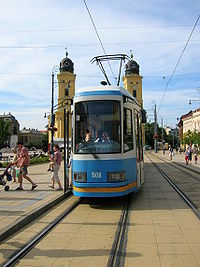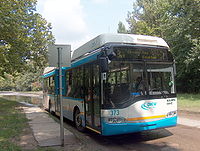
Public transport in Debrecen
Encyclopedia
Public transport in Debrecen, Hungary, is provided by DKV (short for Debrecen
i Közlekedési Vállalat – Public Transport Company of Debrecen; complete name is DKV Zrt.)
Before mid-2009 two companies provided public transport in the city: tram
s and trolleybus
es were operated by DKV while bus
es were operated by Hajdú Volán, which provides transport in the rest of Hajdú-Bihar
county. DKV took over bus transport on July 1 after winning a tender. DKV has 140 buses (40 of which are jointed buses). In the future all buses will be low-floor and 50% of them will be air conditioned.
 The company was founded in 1883 under the name Debrecen Local Tramway Company. They started providing public transport on October 2, 1884 with horse-drawn and steam-powered trams. The first electric tram started operating in 1911. From 1906 the town of Hajdúsámson
The company was founded in 1883 under the name Debrecen Local Tramway Company. They started providing public transport on October 2, 1884 with horse-drawn and steam-powered trams. The first electric tram started operating in 1911. From 1906 the town of Hajdúsámson
and later, the town of Nyírbátor
were connected to Debrecen by municipal railway, also operated by the same company.
By the 1940s there were already ten tram lines. On June 2, 1944 the city was bombed, and the tramway system was seriously damaged. They were repaired by 1947, and seven tram lines were serving the city until the 1970s, which brought a decrease in the popularity of trams. Tramways were demolished all over the country, the role of trams was taken over by buses. Today Debrecen is one of only four Hungarian cities to have a tram line, but even here only one line survived, the rest were demolished. The importance of DKV decreased, the company lost its leading role in the public transport of Debrecen.
Trolleybuses started operating in 1985, several of them serves on lines which used to be tram lines before the 1970s.
The company became state property on July 15, 1950. Today it is city property.
 Between 1970 and 1984 21 FVV trams entered service. The same tram type was used in Budapest
Between 1970 and 1984 21 FVV trams entered service. The same tram type was used in Budapest
, Miskolc
and Szeged
, trams for the latter two cities were built by DKV. The company still owns eight of them, but they can rarely be seen on the streets.
The typical blue trams (KCSV-1S) of Debrecen were built in 1993. There are only 11 of them in the whole world, all of them in Debrecen.
The company also owns an old nostalgia tram.
The trolleybuses ZiU-9
were manufactured in the Soviet Union
, 26 of them entered service since 1985. The four articulated trolleybuses have been in use since 1991. New Solaris Trollino buses are being bought since April 2005, in place of the old Soviet buses. In october 2011 the spanish firm CAF
will be in charge of supply of 18 low floor trams to be delivered from 2014.
Debrecen
Debrecen , is the second largest city in Hungary after Budapest. Debrecen is the regional centre of the Northern Great Plain region and the seat of Hajdú-Bihar county.- Name :...
i Közlekedési Vállalat – Public Transport Company of Debrecen; complete name is DKV Zrt.)
Before mid-2009 two companies provided public transport in the city: tram
Tram
A tram is a passenger rail vehicle which runs on tracks along public urban streets and also sometimes on separate rights of way. It may also run between cities and/or towns , and/or partially grade separated even in the cities...
s and trolleybus
Trolleybus
A trolleybus is an electric bus that draws its electricity from overhead wires using spring-loaded trolley poles. Two wires and poles are required to complete the electrical circuit...
es were operated by DKV while bus
Bus
A bus is a road vehicle designed to carry passengers. Buses can have a capacity as high as 300 passengers. The most common type of bus is the single-decker bus, with larger loads carried by double-decker buses and articulated buses, and smaller loads carried by midibuses and minibuses; coaches are...
es were operated by Hajdú Volán, which provides transport in the rest of Hajdú-Bihar
Hajdú-Bihar
Hajdú-Bihar is an administrative county in eastern Hungary, on the border with Romania. It shares borders with the Hungarian counties Szabolcs-Szatmár-Bereg, Borsod-Abaúj-Zemplén, Jász-Nagykun-Szolnok and Békés. The capital of Hajdú-Bihar county is Debrecen...
county. DKV took over bus transport on July 1 after winning a tender. DKV has 140 buses (40 of which are jointed buses). In the future all buses will be low-floor and 50% of them will be air conditioned.
DKV

Hajdúsámson
Hajdúsámson is a town in Hajdú-Bihar county, in the Northern Great Plain region of eastern Hungary.-Geography:It covers an area of and has a population of 11,573 people ....
and later, the town of Nyírbátor
Nyírbátor
Nyírbátor /ˈɲiːɾbaːtoɾ/ is a town in Szabolcs-Szatmár-Bereg county, in the Northern Great Plain region of eastern Hungary. With its historic atmosphere, this city is known for its 15th- and 16th-century ecclesiastic and secular built heritage and for the family of the former landowners, the Báthory...
were connected to Debrecen by municipal railway, also operated by the same company.
By the 1940s there were already ten tram lines. On June 2, 1944 the city was bombed, and the tramway system was seriously damaged. They were repaired by 1947, and seven tram lines were serving the city until the 1970s, which brought a decrease in the popularity of trams. Tramways were demolished all over the country, the role of trams was taken over by buses. Today Debrecen is one of only four Hungarian cities to have a tram line, but even here only one line survived, the rest were demolished. The importance of DKV decreased, the company lost its leading role in the public transport of Debrecen.
Trolleybuses started operating in 1985, several of them serves on lines which used to be tram lines before the 1970s.
The company became state property on July 15, 1950. Today it is city property.
Trams and trolleys

Budapest
Budapest is the capital of Hungary. As the largest city of Hungary, it is the country's principal political, cultural, commercial, industrial, and transportation centre. In 2011, Budapest had 1,733,685 inhabitants, down from its 1989 peak of 2,113,645 due to suburbanization. The Budapest Commuter...
, Miskolc
Miskolc
Miskolc is a city in northeastern Hungary, mainly with heavy industrial background. With a population close to 170,000 Miskolc is the fourth largest city of Hungary It is also the county capital of Borsod-Abaúj-Zemplén and the regional centre of Northern Hungary.- Geography :Miskolc is located...
and Szeged
Szeged
' is the third largest city of Hungary, the largest city and regional centre of the Southern Great Plain and the county town of Csongrád county. The University of Szeged is one of the most distinguished universities in Hungary....
, trams for the latter two cities were built by DKV. The company still owns eight of them, but they can rarely be seen on the streets.
The typical blue trams (KCSV-1S) of Debrecen were built in 1993. There are only 11 of them in the whole world, all of them in Debrecen.
The company also owns an old nostalgia tram.
The trolleybuses ZiU-9
ZiU-9
ZiU-9 is the Soviet trolleybus vehicle. Other names and indexes for the same vehicle include ZiU-682 and HTI-682 . The ZiU acronym stands for Zavod imeni Uritskogo, which means plant named after Moisei Uritsky, the Russian revolutionary...
were manufactured in the Soviet Union
Soviet Union
The Soviet Union , officially the Union of Soviet Socialist Republics , was a constitutionally socialist state that existed in Eurasia between 1922 and 1991....
, 26 of them entered service since 1985. The four articulated trolleybuses have been in use since 1991. New Solaris Trollino buses are being bought since April 2005, in place of the old Soviet buses. In october 2011 the spanish firm CAF
Construcciones y Auxiliar de Ferrocarriles
Construcciones y Auxiliar de Ferrocarriles is a rail equipment manufacturer based in Beasain in the Basque Country, Spain. Equipment manufactured by CAF includes light rail vehicles, rapid transit trains, railroad cars and locomotives, as well as variable gauge axles that can be fitted on any...
will be in charge of supply of 18 low floor trams to be delivered from 2014.
Buses
Since 2009,the bus lines are also operated by DKV (expect the 3 "CORA" bus lines,that is still operated by Hajdú Volán).Currently,there are over 50 lines (only about 30,when the bus lines with A/Y/I/E or 1 signed bus lines are not counted) and 3 bus types:Volvo Alfa Civis 12,18 and Plasma minibuses (there only 3 from the last type).Tickets
- Ticket: 270 FtHungarian forintThe forint is the currency of Hungary. It is divided into 100 fillér, although fillér coins are no longer in circulation. The introduction of the forint on 1 August 1946 was a crucial step of the post-WWII stabilization of the Hungarian economy, and the currency remained relatively stable until...
- Ticket (when bought on vehicle): 350 Ft
- Ticket for all lines, valid for 1 day: 1100 Ft
- Ticket for all lines, valid for 3 days: 2300 Ft
- Ticket for all lines, valid for 7 days: 3000 Ft
Season tickets (valid for one month)
- Season ticket: 5.890 Ft
- Season ticket for students and pensioners: 2.980 Ft
- Season ticket for persons with small children: 2.970 Ft
Season tickets (other)
- Season ticket for one week: 2.355 Ft
- Season ticket for two weeks: 3.535 Ft
- Season ticket for students & pensioners for 3 months: 8.940 Ft
- Season ticket (with no photo ID, for one month): 17.670 Ft
External links
- DKV official site (Hungarian/English)
- Hajdú Volán official site (Hungarian)
- Pictures about public transport in the large hungarian cities
- Tram in Debrecen (English, German)

